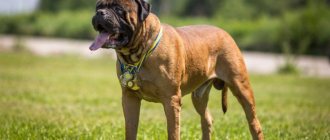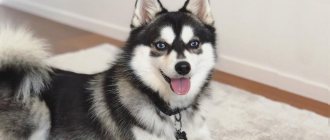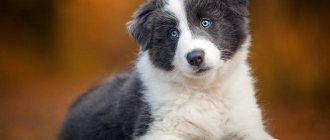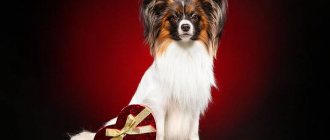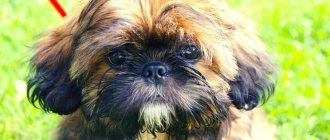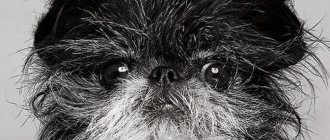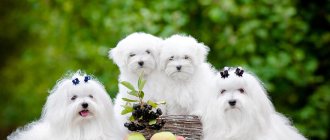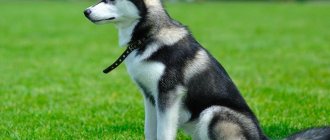Today, many dog breeders prefer to have puppies for beauty, aesthetics and love, since they do not require a special approach to training, daily sports training and the need to live on the street as a guard. In order to develop a new decorative variety, a calm, independent Husky was crossed with a miniature Spitz. As a result, a stunning Pomsky breed was born, which immediately gained love and popularity on the Internet. A pretty appearance and a kind character are the main qualities of a furry, four-legged friend.
Characteristics and description of the breed
Decorative dogs were bred through numerous experiments and experiments. Character traits, like external data, are completely inherited from parents, undergoing genetic changes. At the moment, the breed does not have a large-scale distribution, since it has not been amenable to the study of characteristic features and the development of general standards.
Aggressiveness
They don't know what aggression is. They are absolutely defenseless, so they need a strong, good-natured and attentive mentor. Trying to raise a Pomsky to be a protector is a waste of time and effort.
Activity
Very playful and playful pets. They love to take long walks, run and play. They often make good companions. When the opportunity arises, they will try to escape in search of exciting adventures and fun. Therefore, it is necessary to monitor the dog and teach it from childhood to calmness and moderate activity.
Training
They enjoy training and learning new teams. They love to learn new things. They quickly master standard training and listen to their owner if he pampers them with love and treats.
Pomskies do not tolerate harsh language or threats. If pets are not surrounded by love and affection, they begin to live an independent life without the help of household members.
Shedding
They shed heavily, especially during adolescence. The breed is not suitable for those who are prone to allergies. During the change of undercoat, it is necessary to comb several times a day.
Need for care
They do not require expensive, lengthy care procedures. It is enough to comb the fur during the molting period, clean the ears, eyes and wipe the paws after a walk. Bath once every 2 weeks.
Friendliness and attitude towards children
They are very self-sufficient and freedom-loving, so in some periods they may not pay attention to the people around them and strangers. They also treat children with indifference and sometimes play with them, but without fanaticism.
Health
From birth they have strong immunity and resistance to external irritants. The only caveat is the inheritance of chronic diseases from parents.
Attitude towards loneliness
They cannot stand being alone for a long time; it is important for them to constantly be near their beloved owner. With proper upbringing, they patiently wait for members of the household to arrive and know how to keep themselves busy.
If a dog is alone in an apartment for a long time, it needs entertainment items, such as toys, exercise equipment and special houses.
Maintenance cost
The maintenance depends entirely on the daily diet and type of food, the number of trips to the veterinarian and visits to the hairdresser per month. On average, the amount is similar to that spent on keeping a Pomeranian.
Read Description of the Austrian Smooth-haired Pinscher breed
Intelligence
Developed intelligence and increased learning ability. Pomskies can hardly be called lazy pets; they are always active, determined and attentive.
Noise
They can be silent if properly raised and explained the importance of silence at certain moments. Some “instances” are real talkative fidgets who cannot be calmed down.
Security qualities
There are no security qualities. If danger threatens, the dog can attack the enemy, but most often it is timid and does not know how to defend itself. This is an ornamental breed that does not tolerate conflicts.
Lifespan
The lifespan of a pet is determined by its health and inherited diseases from its parents. On average, dogs live up to 14-15 years.
Life expectancy is determined by proper care, regular examinations and timely vaccinations.
Socialization
Pomsky is a breed of dog with an unsettled character. It is difficult to immediately understand whose genes will become dominant - an independent, independent husky or a good-natured, obedient and cheerful Spitz. In any case, socialization of the puppy should begin as early as possible, since Pomskys are not kennel dogs, but companions that live close to people and other animals.
As soon as the puppy gets to a new home, he is introduced to all family members and frequently visiting guests, for example, grandparents and friends. They show him his personal bed, bowl, toys.
Whenever possible, with the exception of times of illness or quarantine after vaccinations, you need to walk your Pomsky in crowded places and at the same time teach him to wear a collar-harness. From the first days at home, it is necessary to accustom the puppy to basic commands, which greatly facilitate the life together of a person and a Pomsky dog. You can study commands either independently at home or with an instructor, in group or individual lessons according to the general training course (GTC). The training process can be complicated by the discrepancy between expected reactions and real ones - for example, instead of the obedience of a Spitz, the stubbornness of a husky can awaken at any moment. Force and rudeness cannot be used, otherwise the dog will withdraw into itself and become nervous.
Story
Hybridization of breeds is widespread in cynology. Crossing allows you to develop new species, thereby analyzing the compatibility of the qualities of the participating representatives. In this way, the Pomsky breed was created, the parents of which were a female husky and a male Spitz. The purpose of breeding and distribution is to create a miniature, decorative dog with an unusual appearance, sociable qualities and developed mental abilities.
In 2013, Teresa Peterson became the first experimenter to become a breeder of this breed. In the same year, a special organization RSA ("American Pomsky Club") was created, advocating for the rights of a breeding species in its registration as a separate species with certain standards.
After the first successful experience, Pomskies quickly gained popularity among dog lovers, thanks to their beauty and innate friendliness. Photos regularly appear on the Internet depicting miniature “fox cubs” with a bewitching look.
Origin
At the end of the last century, breeders in Canada and the USA attempted to produce a new dog called the Pomsky. The name of the breed was formed by combining the names of the Siberian Husky and the Pomeranian Spitz, thanks to which the animal appeared. Pomskies quickly spread among amateur dog breeders in their homeland, and a few years later they came to the UK. From there the unusual dog was brought to Europe, after which it ended up in the CIS. To date, this hybrid has not been identified as a separate breed, so there are no standards for it. However, in their homeland there is an association of Pomsky lovers, uniting all dog owners.
It is difficult for owners to predict the appearance of the future litter, since each new puppy has distinctive external features.
Appearance
The average weight of first generation males does not exceed 7 kg, height up to 40 cm at the withers. Variability of parameters is characteristic, namely an increase in weight of a couple of kilograms and an increase in body length. The girl's weight is 4-6 kg, height is 25-30 cm. Puppies' height and weight vary depending on their genes.
To accurately determine external characteristics, cynologists distinguish the following exterior types of Pomsky:
- “fox” subspecies - a modified body from a husky and the appearance of an orange. Sharp muzzle, fiery red coat color, semi-long undercoat;
- plush appearance - airy fur and the appearance of a spitz, inherits the color of a husky. A characteristic feature is a large, curled tail;
- white type – snow-white coat and large body;
- brown blue-eyed - large dogs, with a double undercoat. The muzzle is elongated, the color is brown;
- short-haired – the owner of a hard, short coat and the appearance of a Spitz.
Head
The head is small, like a Spitz, proportionate to the body and muzzle. Most often round in shape, small in width.
Eyes
Heterochromia (different eye colors) is characteristic; often there are contrasting spots on the irises. Most have brown, hazel with a yellow tint, blue and green eyes. Round in shape, close set.
Ears
The ears are medium in size and set high. Straight shape, with wool cover. Sometimes they inherit the drooping shape and small size of Spitz dogs.
Read Poodle - circus performer and cheerful friend
Jaws
The jaws are well developed and have a scissor bite, like those of Pomeranians. The teeth are positioned vertically.
Torso
The first litter is elongated, with a strong skeleton. The second group has a miniature body with fragile bones. The rest are the largest representatives, with a developed constitution.
Neck
The neck is short and rounded. It has smooth transition lines and is well developed.
Tail
The tail is not long, fluffy, and set high. The second group has a thick, low-set, curled tail.
Paws
The legs are short with well-developed muscles. The stand is strong, the legs are parallel to each other. The pads are dark, the claws need regular treatment.
Wool
Semi-long, with dense undercoat. Regularly updated and requires maintenance.
Color
The most popular color is smoky shades with an unusual mask on the face, namely: black and white, silver, gray fawn, brown, gold and copper tones. Mixed or single color is acceptable.
Key points in training
It is necessary to raise the descendants of primitive Spitz dogs from the first day they appear in the house. Mixed breeds have a rather stubborn disposition, but in puppyhood they are quite easy to control. Training must be done with positive reinforcement, otherwise the Pomsky may completely refuse to follow commands.
Pomskys use their favorite toy or treat as motivation.
From the husky, the breed inherited a tendency to run away, therefore, unless you have achieved 100% obedience from your pet, it is not recommended to let it off the leash. Training should be short but daily. It is better to practice 1 command for 5 minutes, but 3 – 4 times a day. This way the puppy doesn’t get tired of the activities, and working with the owner becomes much more interesting.
Despite its miniature size and pretty face, the Pomsky is absolutely not suitable for a novice dog breeder. The breed requires persistent and systematic training. The trainer must be even more stubborn than the dog itself.
Read about how to properly train a dog in the article: “Training a puppy: effective methods from dog handlers, learning commands at home.”
Character
Character is formed in the process of education and growing up. Most often, dogs are sociable, friendly and freedom-loving. They are content with the company of people.
They are non-conflict, do not feel competition when meeting strangers. They get along with other pets, or rather, they do not pay attention to them until certain moments. Negative traits include a tendency to run away and excessive activity.
The dog inherits all its traits from its parents. But due to the fact that the dog is prone to learning, its peculiar disposition can be improved.
They love children, but outwardly show indifference to them. Most often they play and communicate with them without harming them.
Nutrition
The Pomsky's diet should be balanced, with sufficient energy value, containing essential vitamins, microelements, and amino acids. Dry food of the holistic, super premium and premium classes can provide the correct diet. Feeding ready-made food allows you not to worry about vitamin supplements, food freshness, overeating or undereating your pet. The dry diet can be varied with wet canned food, while giving preference to food from one manufacturer and one brand. We have already written about how to choose dog food and how to feed your dog dry food.
Adherents of natural nutrition should know that dogs should absolutely not be given:
- fatty foods;
- smoked and pickled foods;
- baked goods and sweets, chocolate;
- raw meat and fish;
- bones.
A natural diet should also be balanced in nutritional value and content of nutrients:
- 50-60% of the daily portion of food should be meat (veal, lamb, poultry, rabbit);
- 20-25% vegetables and fruits;
- 25-30% cereals;
- 5% fermented milk products.
A natural diet should include eggs (chicken, quail), offal (liver, tongue, tripe, heart, lungs), and low-fat fish. It is advisable to consult with the breeder or veterinarian regarding the introduction of vitamin and mineral supplements.
Maintenance and care
For proper care, the main thing is to visit the veterinarian in a timely manner and follow the principles of proper nutrition.
Nutrition
Nature has endowed Pomskies with a fast metabolism and a “strong” stomach, so a special diet is not required. Changes in diet are resorted to only in case of regular participation in various competitions and events.
Mestizos eat simple food. The optimal diet should consist of the following products:
- lean meat, boiled offal;
- rice or oatmeal porridge;
- boiled or steamed seasonal vegetables;
- low-fat fermented milk products.
The simplest option is to switch to premium dry food. They contain a vitamin-mineral complex and natural ingredients. At the same time, dry kibble helps puppies sharpen their strong teeth.
Dry food should be introduced into the diet gradually. It is better to start at a young age, giving the puppy minimal portions of a few grams.
Hygiene
The fur perfectly protects them from dirt, dust and high humidity, so there is no need for frequent bathing. It is enough to perform skincare procedures a couple of times a month using special detergents. Then the hairs are dried with a soft towel and dried with a hairdryer on low heat.
Thick coats need to be combed, especially during shedding periods. In normal times, comb out a couple of times every 7 days.
You also need to keep an eye on the ears and eyes. Regularly clean them of secretions with a cotton swab. In this case, it is better not to use special cleaning products so as not to injure the mucous membrane.
Read Prague Rat - description and photo of a miniature dog
Health and illness
Teeth and eyes are especially vulnerable. Over time, tartar or tooth decay may develop and can be easily treated. By maturity, the former acuity of vision and smell is lost. Allergic reactions may also develop, so you need to monitor your diet. The most dangerous thing is genetic diseases transmitted from parents.
Mating
In most cases, Pomskies are bred artificially by inseminating a Husky bitch with genetic material from a Pomeranian male. When mating mestizos, fertilization occurs naturally. The only thing is that the parents must be of the same subspecies.
Walks
The average duration of a walk is at least 1.5 hours twice a day with a light jog. This will be enough to satisfy the Pomsky's innate need for freedom. In the opposite situation, the pet will not be upset if it stays at home.
Health
Pomsky is a mixed breed, therefore it has good immunity and health, since different breeds are less likely to pass purebred diseases to their common children. This is called the “hybrid power” effect. Moreover, one of the ancestors of the Pomsky is the Husky, a strong Siberian dog with excellent health.
Diseases
There are several problems common to Pomsky dogs:
- Formation of tartar. Prevent by brushing your teeth; such treats as “dry veins”, “dried ears”, etc. also help. It is not recommended to allow bones to be chewed, as a completely solvable dental problem can develop into a huge problem with the stomach and intestines. Old tartar is removed in veterinary clinics.
- Allergic reactions to any product. The problem can be solved by eliminating the allergen product from the diet.
- Eye diseases in old dogs.
Many health problems can be avoided by regularly visiting veterinary clinics and getting your dog vaccinated according to age.
Vaccinations
Vaccinations are mandatory for all dogs. This saves the life of the pet, and sometimes the health of family members. In addition, without vaccinations and a completed veterinary passport, a dog is not allowed to participate in exhibitions or be transported in transport (on planes, trains). The first vaccinations against rabies, enteritis and distemper are given to puppies while still in the nursery, at 6-10 weeks. You should then adhere to the annual revaccination schedule.
Pros and cons of the breed
Owners of handsome mestizos highlight the following advantages:
- Developed mental abilities, which allows the dog to easily learn training commands.
- Friendliness and lack of conflict will never provoke a conflict situation with other dogs. Enjoys communicating with other people and children.
- Lack of aggression even when influenced by external stimuli.
- Independence - will be able to stay alone for a long time without requiring undue attention.
- Calmness and affectionate attitude towards loved ones, especially the owner.
Disadvantages include:
- Lack of a standard for mestizos - participation in official Pomsky exhibitions is not yet possible, since the breed is not registered in the appropriate registry.
- With each litter - new character traits, predisposition to genetic diseases and external features.
- They grow up either very active or very lazy, but always require regular walks. This factor can be corrected with education and patience.
Mating
Since the Pomsky is actually a cross between a Spitz and a Siberian Husky, second and third generation hybrids are not mated to each other. Only the first generation of mixed breeds are considered true Pomskies . Subsequent hybridization leads to fragmentation of genes, and the puppies turn into ordinary “mongrels”, losing all the exterior attractiveness of the breed.
Mating is carried out only in specialized nurseries of hybrid dogs, through artificial insemination. In order for the gestation of puppies and childbirth to take place safely for the litter, parental roles are distributed as follows:
- The mother is a female Siberian Husky.
- Father is a male Spitz.
At home, without special equipment for artificial insemination, it is impossible to breed a Pomsky.
Read a detailed article on the topic: “Everything you need to know about breeding dogs: appropriate age, what to do if it doesn’t work out, rules and tips.”
Photo
Mini Pomsky
The plush type of mestizo is the smallest, which is why it is also called mini pomsky. He looks like a standard Pomeranian, with the coat and eyes of a husky. The miniature Pomsky is the most expensive type because it looks incredibly funny.
Plush small dogs with original colors are gaining a huge number of followers on social networks. Most owners of such dogs maintain pages for their pets on their behalf. Photos of unusual “eternal husky puppies” are gaining a large number of views. Such pages are very popular, thanks to which the owners have the opportunity to earn money from advertising.
How to choose a puppy
Before buying a puppy, you need to check with the breeder about the generation of the hybrid of the current offspring.
The first generation is considered the most valuable, due to its “harmonious” appearance and good health. To find out the character of the baby, you need to get to know one of his parents and observe his behavior. In the first months of life, eye color changes shade. If you want to buy a brown-eyed mestizo, you should wait about three months for the final formation of the iris. After purchase, any breeder must provide:
- pedigree;
- international veterinary passport;
- certificate of registration in the RSA or ASNS.
Tips for choosing
Choosing the right place to purchase a puppy will eliminate the possibility of buying a sick dog with pathologies. It is best to purchase a pet from nurseries after first getting to know the breeder and the puppy’s parents, as well as assessing the conditions in which the animals are kept.
Ungroomed, sick dogs kept in dirty enclosures and the breeder’s avoidance of answering questions and refusal to present the pedigree and medical records of the parents are reasons to be wary.
When choosing a puppy, you need to pay attention not only to its appearance, but also to its activity, as well as to:
- Cleanliness, uniformity, thickness of the coat.
- No discharge from the eyes.
- Proportionality of the abdomen.
- Ear placement - they should look up.
- No skin inflammation.
- Cleanliness of the ears.
Also, you should not buy a puppy before it is 2-3 months old. It is at this age that breed traits begin to appear and it is easier to judge what kind of adult dog will be.
Interesting facts from the life of dogs
Four-legged creatures have a huge number of features, some of which have never even been thought of. A few of them:
- In fact, mestizo people really don't like hugs.
- Due to irregular hygiene, bacteria accumulate on these dogs' paws and they begin to smell like chips. So, when you smell a scent, there is no need to rush to scold your animal.
- These dogs have excellent hearing. This helps them navigate faster in case of danger (for example, when a storm is approaching).
- Before doing anything, the dog waits for permission from the leader.
This is interesting: The best nicknames for huskies: popular nicknames for boys and girls

